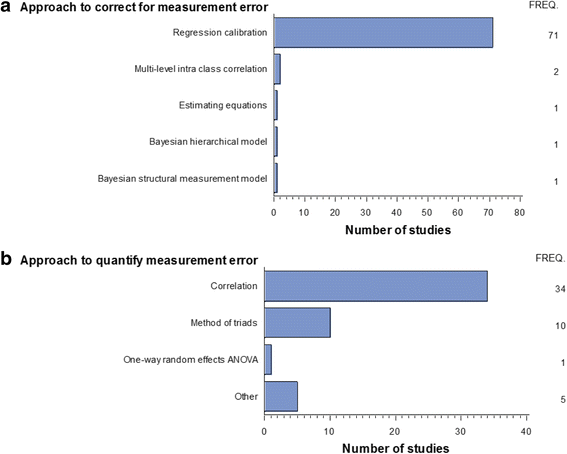Systematic review of statistical approaches to quantify, or correct for, measurement error in a continuous exposure in nutritional epidemiology
- PMID: 28927376
- PMCID: PMC5606038
- DOI: 10.1186/s12874-017-0421-6
Systematic review of statistical approaches to quantify, or correct for, measurement error in a continuous exposure in nutritional epidemiology
Abstract
Background: Several statistical approaches have been proposed to assess and correct for exposure measurement error. We aimed to provide a critical overview of the most common approaches used in nutritional epidemiology.
Methods: MEDLINE, EMBASE, BIOSIS and CINAHL were searched for reports published in English up to May 2016 in order to ascertain studies that described methods aimed to quantify and/or correct for measurement error for a continuous exposure in nutritional epidemiology using a calibration study.
Results: We identified 126 studies, 43 of which described statistical methods and 83 that applied any of these methods to a real dataset. The statistical approaches in the eligible studies were grouped into: a) approaches to quantify the relationship between different dietary assessment instruments and "true intake", which were mostly based on correlation analysis and the method of triads; b) approaches to adjust point and interval estimates of diet-disease associations for measurement error, mostly based on regression calibration analysis and its extensions. Two approaches (multiple imputation and moment reconstruction) were identified that can deal with differential measurement error.
Conclusions: For regression calibration, the most common approach to correct for measurement error used in nutritional epidemiology, it is crucial to ensure that its assumptions and requirements are fully met. Analyses that investigate the impact of departures from the classical measurement error model on regression calibration estimates can be helpful to researchers in interpreting their findings. With regard to the possible use of alternative methods when regression calibration is not appropriate, the choice of method should depend on the measurement error model assumed, the availability of suitable calibration study data and the potential for bias due to violation of the classical measurement error model assumptions. On the basis of this review, we provide some practical advice for the use of methods to assess and adjust for measurement error in nutritional epidemiology.
Keywords: Continuous exposure; Measurement error; Nutrition; Statistical methods.
Conflict of interest statement
Ethics approval and consent to participate
Not applicable.
Consent for publication
Not applicable.
Competing interests
The authors declare that they have no competing interests.
Publisher’s Note
Springer Nature remains neutral with regard to jurisdictional claims in published maps and institutional affiliations.
Figures


References
-
- Teicholz N. The scientific report guiding the US dietary guidelines: is it scientific? Br Med J. 2015;351 - PubMed
-
- Ravnskov U, DiNicolantonio JJ, Harcombe Z, Kummerow FA, Okuyama H, Worm N. The questionable benefits of exchanging saturated fat with polyunsaturated fat. Mayo Clin Proc. 89(4):451–3. - PubMed
Publication types
MeSH terms
Grants and funding
LinkOut - more resources
Full Text Sources
Other Literature Sources
Medical
Miscellaneous

